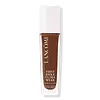Wet n Wild Barefocus Tinted Hydrator Tinted Skin Veil Versus Lancôme Teint Idole Ultra Wear Care and Glow Serum Foundation
What's inside
What's inside
 Key Ingredients
Key Ingredients

 Benefits
Benefits

 Concerns
Concerns

No concerns
 Ingredients Side-by-side
Ingredients Side-by-side

Water
Skin ConditioningCyclopentasiloxane
EmollientButylene Glycol
HumectantGlycerin
HumectantDisteardimonium Hectorite
StabilisingCetyl PEG/PPG-10/1 Dimethicone
EmulsifyingLauryl PEG-10 Tris(Trimethylsiloxy)Silylethyl Dimethicone
EmulsifyingPhenoxyethanol
PreservativeMagnesium Sulfate
Triethoxycaprylylsilane
Ethylhexylglycerin
Skin ConditioningDimethicone/Vinyl Dimethicone Crosspolymer
Skin ConditioningSqualane
EmollientSodium Hyaluronate
HumectantHydrolyzed Hyaluronic Acid
HumectantCI 77891
Cosmetic ColorantIron Oxides
CI 77492
Cosmetic ColorantCI 77499
Cosmetic ColorantWater, Cyclopentasiloxane, Butylene Glycol, Glycerin, Disteardimonium Hectorite, Cetyl PEG/PPG-10/1 Dimethicone, Lauryl PEG-10 Tris(Trimethylsiloxy)Silylethyl Dimethicone, Phenoxyethanol, Magnesium Sulfate, Triethoxycaprylylsilane, Ethylhexylglycerin, Dimethicone/Vinyl Dimethicone Crosspolymer, Squalane, Sodium Hyaluronate, Hydrolyzed Hyaluronic Acid, CI 77891, Iron Oxides, CI 77492, CI 77499
Dimethicone
EmollientWater
Skin ConditioningIsododecane
EmollientAlcohol Denat.
AntimicrobialTrimethylsiloxysilicate
EmollientPropylene Glycol
HumectantGlycerin
HumectantPEG/PPG-18/18 Dimethicone
EmulsifyingSilica
AbrasiveSynthetic Fluorphlogopite
Polysilicone-11
Rosa Gallica Flower Extract
AstringentMoringa Oleifera Seed Extract
Skin ConditioningPolymnia Sonchifolia Root Juice
Skin ConditioningSorbitol
HumectantMandelic Acid
AntimicrobialPEG-10 Dimethicone
Skin ConditioningAlpha-Glucan Oligosaccharide
CleansingSodium Chloride
MaskingSodium Hyaluronate
HumectantSodium Hydroxide
BufferingSilica Silylate
EmollientCellulose Acetate Butyrate
Aluminum Hydroxide
EmollientAmmonium Polyacryloyldimethyl Taurate
Emulsion StabilisingDisodium Phosphate
BufferingDisodium Stearoyl Glutamate
CleansingHydroxyethylpiperazine Ethane Sulfonic Acid
BufferingCaprylyl Glycol
EmollientCitric Acid
BufferingLactobacillus
Skin ConditioningMaltodextrin
AbsorbentPolyphosphorylcholine Glycol Acrylate
Polyvinyl Alcohol
Butylene Glycol
HumectantTocopherol
AntioxidantPhenoxyethanol
PreservativeParfum
MaskingLinalool
PerfumingGeraniol
PerfumingLimonene
PerfumingCitral
PerfumingCitronellol
PerfumingBenzyl Alcohol
PerfumingTitanium Dioxide
Cosmetic ColorantIron Oxides
Dimethicone, Water, Isododecane, Alcohol Denat., Trimethylsiloxysilicate, Propylene Glycol, Glycerin, PEG/PPG-18/18 Dimethicone, Silica, Synthetic Fluorphlogopite, Polysilicone-11, Rosa Gallica Flower Extract, Moringa Oleifera Seed Extract, Polymnia Sonchifolia Root Juice, Sorbitol, Mandelic Acid, PEG-10 Dimethicone, Alpha-Glucan Oligosaccharide, Sodium Chloride, Sodium Hyaluronate, Sodium Hydroxide, Silica Silylate, Cellulose Acetate Butyrate, Aluminum Hydroxide, Ammonium Polyacryloyldimethyl Taurate, Disodium Phosphate, Disodium Stearoyl Glutamate, Hydroxyethylpiperazine Ethane Sulfonic Acid, Caprylyl Glycol, Citric Acid, Lactobacillus, Maltodextrin, Polyphosphorylcholine Glycol Acrylate, Polyvinyl Alcohol, Butylene Glycol, Tocopherol, Phenoxyethanol, Parfum, Linalool, Geraniol, Limonene, Citral, Citronellol, Benzyl Alcohol, Titanium Dioxide, Iron Oxides
 Reviews
Reviews

Ingredients Explained
These ingredients are found in both products.
Ingredients higher up in an ingredient list are typically present in a larger amount.
Butylene Glycol (or BG) is used within cosmetic products for a few different reasons:
Overall, Butylene Glycol is a safe and well-rounded ingredient that works well with other ingredients.
Though this ingredient works well with most skin types, some people with sensitive skin may experience a reaction such as allergic rashes, closed comedones, or itchiness.
Learn more about Butylene GlycolGlycerin is already naturally found in your skin. It helps moisturize and protect your skin.
A study from 2016 found glycerin to be more effective as a humectant than AHAs and hyaluronic acid.
As a humectant, it helps the skin stay hydrated by pulling moisture to your skin. The low molecular weight of glycerin allows it to pull moisture into the deeper layers of your skin.
Hydrated skin improves your skin barrier; Your skin barrier helps protect against irritants and bacteria.
Glycerin has also been found to have antimicrobial and antiviral properties. Due to these properties, glycerin is often used in wound and burn treatments.
In cosmetics, glycerin is usually derived from plants such as soybean or palm. However, it can also be sourced from animals, such as tallow or animal fat.
This ingredient is organic, colorless, odorless, and non-toxic.
Glycerin is the name for this ingredient in American English. British English uses Glycerol/Glycerine.
Learn more about GlycerinPhenoxyethanol is a preservative that has germicide, antimicrobial, and aromatic properties. Studies show that phenoxyethanol can prevent microbial growth. By itself, it has a scent that is similar to that of a rose.
It's often used in formulations along with Caprylyl Glycol to preserve the shelf life of products.
Sodium Hyaluronate is hyaluronic acid's salt form. It is commonly derived from the sodium salt of hyaluronic acid.
Like hyaluronic acid, it is great at holding water and acts as a humectant. This makes it a great skin hydrating ingredient.
Sodium Hyaluronate is naturally occurring in our bodies and is mostly found in eye fluid and joints.
These are some other common types of Hyaluronic Acid:
Learn more about Sodium HyaluronateWater. It's the most common cosmetic ingredient of all. You'll usually see it at the top of ingredient lists, meaning that it makes up the largest part of the product.
So why is it so popular? Water most often acts as a solvent - this means that it helps dissolve other ingredients into the formulation.
You'll also recognize water as that liquid we all need to stay alive. If you see this, drink a glass of water. Stay hydrated!
Learn more about WaterThis ingredient is a combination of red, black, and yellow iron oxide pigments. This combination of colors is usually found in foundation, because it results in a "skin" color.